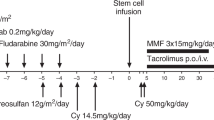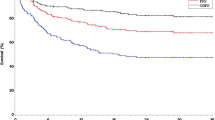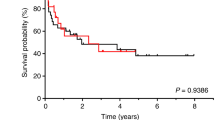Abstract
Prognosis is poor for patients with biologically aggressive Non-Hodgkin lymphoma (NHL), refractory to chemotherapy or relapsed after autologous transplantation, especially when no disease control before allogeneic transplantation is achieved. In 16 patients (median age 53, median prior regimes 5) with relapsed or refractory non-remission NHL, we analysed retrospectively the efficacy of a sequential therapy comprising clofarabine re-induction followed by a reduced-intensity conditioning with fludarabine, CY and melphalan, and T-cell-replete HLA-haploidentical transplantation. High-dose CY was utilized post-transplantation. All patients engrafted. Early response (day +30) was achieved in 94%. Treatment-related grade III-IV toxicity occurred in 56%, most commonly transient elevation of transaminases (36%), while there was a low incidence of infections (19% CMV reactivation, 19% invasive fungal infection) and GVHD (GVHD: acute III-IV: 6%; mild chronic: 25%). One-year non-relapse mortality was 19%. After a median follow-up of 21 months, estimated 1- and 2-year PFS was 56 and 50%, respectively, with 11 patients (69%) still alive after 2 years. In summary, sequential therapy is feasible and effective and provides an acceptable toxicity profile in high-risk non-remission NHL. Presumably, cytotoxic reinduction with clofarabine provides enough remission time for the graft-versus lymphoma effect of HLA-haploidentical transplantation to kick in, even in lymphomas that are otherwise chemo-refractory.
This is a preview of subscription content, access via your institution
Access options
Subscribe to this journal
Receive 12 print issues and online access
$259.00 per year
only $21.58 per issue
Buy this article
- Purchase on Springer Link
- Instant access to full article PDF
Prices may be subject to local taxes which are calculated during checkout



Similar content being viewed by others
References
Khouri IF, Champlin RE . Nonmyeloablative allogeneic stem cell transplantation for non-hodgkin lymphoma. Cancer J 2012; 18: 457–462.
Bishop MR, Dean RM, Steinberg SM, Odom J, Pavletic SZ, Chow C et al. Clinical evidence of a graft-versus-lymphoma effect against relapsed diffuse large B-cell lymphoma after allogeneic hematopoietic stem-cell transplantation. Ann Oncol 2008; 19: 1935–1940.
Sirvent A, Dhedin N, Michallet M, Mounier N, Faucher C, Yakoub-Agha I et al. Low nonrelapse mortality and prolonged long-term survival after reduced-intensity allogeneic stem cell transplantation for relapsed or refractory diffuse large B cell lymphoma: report of the Societe Francaise de Greffe de Moelle et de Therapie Cellulaire. BiolBMT 2010; 16: 78–85.
van Kampen RJ, Canals C, Schouten HC, Nagler A, Thomson KJ, Vernant JP et al. Allogeneic stem-cell transplantation as salvage therapy for patients with diffuse large B-cell non-Hodgkin's lymphoma relapsing after an autologous stem-cell transplantation: an analysis of the European Group for Blood and Marrow Transplantation Registry. J Clin Oncol 2011; 29: 1342–1348.
Schmid C, Schleuning M, Ledderose G, Tischer J, Kolb HJ . Sequential regimen of chemotherapy, reduced-intensity conditioning for allogeneic stem-cell transplantation, and prophylactic donor lymphocyte transfusion in high-risk acute myeloid leukemia and myelodysplastic syndrome. J Clin Oncol 2005; 23: 5675–5687.
Schmid C, Schleuning M, Schwerdtfeger R, Hertenstein B, Mischak-Weissinger E, Bunjes D et al. Long-term survival in refractory acute myeloid leukemia after sequential treatment with chemotherapy and reduced-intensity conditioning for allogeneic stem cell transplantation. Blood 2006; 108: 1092–1099.
Kasamon YL, Luznik L, Leffell MS, Kowalski J, Tsai HL, Bolanos-Meade J et al. Nonmyeloablative HLA-haploidentical bone marrow transplantation with high-dose posttransplantation cyclophosphamide: effect of HLA disparity on outcome. Biol BMT 2010; 16: 482–489.
Burroughs LM, O'Donnell PV, Sandmaier BM, Storer BE, Luznik L, Symons HJ et al. Comparison of outcomes of HLA-matched related, unrelated, or HLA-haploidentical related hematopoietic cell transplantation following nonmyeloablative conditioning for relapsed or refractory Hodgkin lymphoma. Biol BMT 2008; 14: 1279–1287.
Nabhan C, Davis N, Bitran JD, Galvez A, Fried W, Tolzien K et al. Efficacy and safety of clofarabine in relapsed and/or refractory non-Hodgkin lymphoma, including rituximab-refractory patients. Cancer 2011; 117: 1490–1497.
Abramson JS, Takvorian RW, Fisher DC, Feng Y, Jacobsen ED, Brown JR et al. Oral clofarabine for relapsed/refractory non-Hodgkin lymphomas: results of a phase 1 study. Leukemia Lymphoma 2013; 54: 1915–1920.
Magenau J, Tobai H, Pawarode A, Braun T, Peres E, Reddy P et al. Clofarabine and busulfan conditioning facilitates engraftment and provides significant antitumor activity in nonremission hematologic malignancies. Blood 2011; 118: 4258–4264.
Tischer J, Stemmler HJ, Engel N, Hubmann M, Fritsch S, Prevalsek D et al. Feasibility of clofarabine cytoreduction followed by haploidentical hematopoietic stem cell transplantation in patients with relapsed or refractory advanced acute leukemia. Ann Hematol 2013; 92: 1379–1388.
Buchholz S, Dammann E, Stadler M, Krauter J, Beutel G, Trummer A et al. Cytoreductive treatment with clofarabine/ara-C combined with reduced-intensity conditioning and allogeneic stem cell transplantation in patients with high-risk, relapsed, or refractory acute myeloid leukemia and advanced myelodysplastic syndrome. Eur J Haematol 2012; 88: 52–60.
Locke FL, Artz A, Rich E, Zhang Y, van Besien K, Stock W . Feasibility of clofarabine cytoreduction before allogeneic transplant conditioning for refractory AML. BMT 2010; 45: 1692–1698.
Luznik L, O'Donnell PV, Symons HJ, Chen AR, Leffell MS, Zahurak M et al. HLA-haploidentical bone marrow transplantation for hematologic malignancies using nonmyeloablative conditioning and high-dose, posttransplantation cyclophosphamide. Biol BMT 2008; 14: 641–650.
Raiola A, Dominietto A, Varaldo R, Ghiso A, Galaverna F, Bramanti S et al. Unmanipulated haploidentical BMT following non-myeloablative conditioning and post-transplantation CY for advanced Hodgkin's lymphoma. BMT 2014; 49: 190–194.
Cheson BD, Pfistner B, Juweid ME, Gascoyne RD, Specht L, Horning SJ et al. Revised response criteria for malignant lymphoma. J Clin Oncol 2007; 25: 579–586.
Filipovich AH, Weisdorf D, Pavletic S, Socie G, Wingard JR, Lee SJ et al. National Institutes of Health consensus development project on criteria for clinical trials in chronic graft-versus-host disease: I. Diagnosis and staging working group report. Biol BMT 2005; 11: 945–956.
Przepiorka D, Anderlini P, Saliba R, Cleary K, Mehra R, Khouri I et al. Chronic graft-versus-host disease after allogeneic blood stem cell transplantation. Blood 2001; 98: 1695–1700.
De Pauw B, Walsh TJ, Donnelly JP, Stevens DA, Edwards JE, Calandra T et al. Revised definitions of invasive fungal disease from the European Organization for Research and Treatment of Cancer/Invasive Fungal Infections Cooperative Group and the National Institute of Allergy and Infectious Diseases Mycoses Study Group (EORTC/MSG) Consensus Group. Clin Infect Dis 2008; 46: 1813–1821.
Scrucca L, Santucci A, Aversa F . Competing risk analysis using R: an easy guide for clinicians. BMT 2007; 40: 381–387.
Sorror ML, Maris MB, Storb R, Baron F, Sandmaier BM, Maloney DG et al. Hematopoietic cell transplantation (HCT)-specific comorbidity index: a new tool for risk assessment before allogeneic HCT. Blood 2005; 106: 2912–2919.
Ganepola S, Gentilini C, Hilbers U, Lange T, Rieger K, Hofmann J et al. Patients at high risk for CMV infection and disease show delayed CD8+ T-cell immune recovery after allogeneic stem cell transplantation. BMT 2007; 39: 293–299.
Gopal AK, Guthrie KA, Rajendran J, Pagel JM, Oliveira G, Maloney DG et al. (9)(0)Y-Ibritumomab tiuxetan, fludarabine, and TBI-based nonmyeloablative allogeneic transplantation conditioning for patients with persistent high-risk B-cell lymphoma. Blood 2011; 118: 1132–1139.
Eto M, Mayumi H, Tomita Y, Yoshikai Y, Nishimura Y, Maeda T et al. Specific destruction of host-reactive mature T cells of donor origin prevents graft-versus-host disease in cyclophosphamide-induced tolerant mice. J Immunol 1991; 146: 1402–1409.
O'Donnell PV, Luznik L, Jones RJ, Vogelsang GB, Leffell MS, Phelps M et al. Nonmyeloablative bone marrow transplantation from partially HLA-mismatched related donors using posttransplantation cyclophosphamide. Biol BMT 2002; 8: 377–386.
Khouri IF, Keating M, Korbling M, Przepiorka D, Anderlini P, O'Brien S et al. Transplant-lite: induction of graft-versus-malignancy using fludarabine-based nonablative chemotherapy and allogeneic blood progenitor-cell transplantation as treatment for lymphoid malignancies. J Clin Oncol 1998; 16: 2817–2824.
Safdar A, Rodriguez GH, Mihu CN, Mora-Ramos L, Mulanovich V, Chemaly RF et al. Infections in non-myeloablative hematopoietic stem cell transplantation patients with lymphoid malignancies: spectrum of infections, predictors of outcome and proposed guidelines for fungal infection prevention. BMT 2010; 45: 339–347.
Rigacci L, Puccini B, Dodero A, Iacopino P, Castagna L, Bramanti S et al. Allogeneic hematopoietic stem cell transplantation in patients with diffuse large B cell lymphoma relapsed after autologous stem cell transplantation: a GITMO study. Ann Hematol 2012; 91: 931–939.
Thomson KJ, Morris EC, Milligan D, Parker AN, Hunter AE, Cook G et al. T-cell-depleted reduced-intensity transplantation followed by donor leukocyte infusions to promote graft-versus-lymphoma activity results in excellent long-term survival in patients with multiply relapsed follicular lymphoma. J Clin Oncol 2010; 28: 3695–3700.
Wirk B, Fenske TS, Hamadani M, Zhang MJ, Hu ZH, Akpek G et al. Outcomes of hematopoietic cell transplantation for diffuse large B cell lymphoma transformed from follicular lymphoma. Biol BMT 2014; 20: 951–959.
Wondergem MJ, Dijkstra FS, Visser OJ, Zweegman S, Ossenkoppele GJ, Witte BI et al. Allogeneic transplantation after reduced-intensity conditioning with fludarabine-CY for both indolent and aggressive lymphoid malignancies. BMT 2014; 49: 513–518.
Doocey RT, Toze CL, Connors JM, Nevill TJ, Gascoyne RD, Barnett MJ et al. Allogeneic haematopoietic stem-cell transplantation for relapsed and refractory aggressive histology non-Hodgkin lymphoma. Br J Haematol 2005; 131: 223–230.
Hamadani M, Saber W, Ahn KW, Carreras J, Cairo MS, Fenske TS et al. Allogeneic hematopoietic cell transplantation for chemotherapy-unresponsive mantle cell lymphoma: a cohort analysis from the center for international blood and marrow transplant research. Biol BMT 2013; 19: 625–631.
Baron F, Maris MB, Storer BE, Sandmaier BM, Stuart MJ, McSweeney PA et al. HLA-matched unrelated donor hematopoietic cell transplantation after nonmyeloablative conditioning for patients with chronic myeloid leukemia. Biol BMT 2005; 11: 272–279.
Rezvani AR, Storer B, Maris M, Sorror ML, Agura E, Maziarz RT et al. Nonmyeloablative allogeneic hematopoietic cell transplantation in relapsed, refractory, and transformed indolent non-Hodgkin's lymphoma. J Clin Oncol 2008; 26: 211–217.
Robinson SP, Goldstone AH, Mackinnon S, Carella A, Russell N, de Elvira CR et al. Chemoresistant or aggressive lymphoma predicts for a poor outcome following reduced-intensity allogeneic progenitor cell transplantation: an analysis from the Lymphoma Working Party of the European Group for Blood and Bone Marrow Transplantation. Blood 2002; 100: 4310–4316.
Rezvani AR, Norasetthada L, Gooley T, Sorror M, Bouvier ME, Sahebi F et al. Non-myeloablative allogeneic haematopoietic cell transplantation for relapsed diffuse large B-cell lymphoma: a multicentre experience. Br J Haematol 2008; 143: 395–403.
Zeidan AM, Forde PM, Symons H, Chen A, Smith BD, Pratz K et al. HLA-haploidentical donor lymphocyte infusions for patients with relapsed hematologic malignancies after related HLA-haploidentical bone marrow transplantation. Biol BMT 2014; 20: 314–318.
Chevallier P, Labopin M, Milpied N, Bilger K, Socie G, Yakoub-Agha I et al. Outcomes of adults with active or progressive hematological malignancies at the time of allo-SCT: a survey from the Societe Francaise de Greffe de Moelle et de Therapie Cellulaire (SFGM-TC). BMT 2014; 49: 361–365.
Sauter CS, Chou JF, Papadopoulos EB, Perales MA, Jakubowski AA, Young JW et al. A prospective study of an alemtuzumab containing reduced-intensity allogeneic stem cell transplant program in patients with poor-risk and advanced lymphoid malignancies. Leukemia Lymphoma 2014; 55: 2739–2747.
Glass B, Hasenkamp J, Wulf G, Dreger P, Pfreundschuh M, Gramatzki M et al. Rituximab after lymphoma-directed conditioning and allogeneic stem-cell transplantation for relapsed and refractory aggressive non-Hodgkin lymphoma (DSHNHL R3): an open-label, randomised, phase 2 trial. Lancet Oncol 2014; 15: 757–766.
Author information
Authors and Affiliations
Corresponding author
Ethics declarations
Competing interests
The authors declare no conflict interests.
Rights and permissions
About this article
Cite this article
Zoellner, AK., Fritsch, S., Prevalsek, D. et al. Sequential therapy combining clofarabine and T-cell-replete HLA-haploidentical haematopoietic SCT is feasible and shows efficacy in the treatment of refractory or relapsed aggressive lymphoma. Bone Marrow Transplant 50, 679–684 (2015). https://doi.org/10.1038/bmt.2014.328
Received:
Revised:
Accepted:
Published:
Issue Date:
DOI: https://doi.org/10.1038/bmt.2014.328
This article is cited by
-
Allogene Blutstammzelltransplantation: Etabliertes und Neues
InFo Hämatologie + Onkologie (2021)
-
Allogeneic stem cell transplantation for peripheral T cell lymphomas: a retrospective study in 285 patients from the Société Francophone de Greffe de Moelle et de Thérapie Cellulaire (SFGM-TC)
Journal of Hematology & Oncology (2020)
-
Haploidentical stem cell transplantation for patients with lymphoma: a position statement from the Lymphoma Working Party-European Society for Blood and Marrow Transplantation
Bone Marrow Transplantation (2020)
-
Aktuelle Therapiestrategien beim Mantelzelllymphom
Der Internist (2016)



